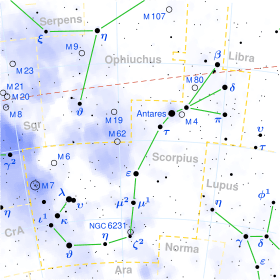Q Scorpii
Q Scorpii (Q Sco) is an orange giant star in the constellation Scorpius. Its apparent magnitude is 4.27. It lies in the tail of Scorpius, between the stars λ Scorpii and μ Scorpii, 7′ from the faint globular cluster Tonantzintla 2.
| Observation data Epoch J2000.0 Equinox J2000.0 | |
|---|---|
| Constellation | Scorpius |
| Right ascension | 17h 36m 32.8529s[1] |
| Declination | −38° 38′ 06.909″[1] |
| Apparent magnitude (V) | 4.267[2] |
| Characteristics | |
| Spectral type | G8/K0III/IV[3] |
| Astrometry | |
| Radial velocity (Rv) | −48.70[4] km/s |
| Proper motion (μ) | RA: −14.985[1] mas/yr Dec.: −217.033[1] mas/yr |
| Parallax (π) | 10.2484 ± 0.6574[1] mas |
| Distance | 320 ± 20 ly (98 ± 6 pc) |
| Absolute magnitude (MV) | +1.047[5] |
| Details | |
| Mass | 1.30[5] M☉ |
| Radius | 12.66[1] R☉ |
| Luminosity | 70.433[1] L☉ |
| Surface gravity (log g) | 2.52[5] cgs |
| Temperature | 4,596[5] K |
| Metallicity [Fe/H] | −0.25[5] dex |
| Other designations | |
| Database references | |
| SIMBAD | data |
Q Scorii is a suspected astrometric binary,[6] a star whose position is seen to oscillate although no companion has been detected. From Hipparcos data, its proper motion is seen to be discrepant and accelerating, although there is insufficient data to determine any orbit.[7]
Q Scorpii is cooler than the sun, but more luminous. It is a red clump giant, at the cool end of the horizontal branch, fusing helium in its core.[8][5] Like all red clump giants, it has an effective temperature near 5,000 K and a bolometric luminosity of around 75 L☉.
References
- Brown, A. G. A.; et al. (Gaia collaboration) (August 2018). "Gaia Data Release 2: Summary of the contents and survey properties". Astronomy & Astrophysics. 616. A1. arXiv:1804.09365. Bibcode:2018A&A...616A...1G. doi:10.1051/0004-6361/201833051. Gaia DR2 record for this source at VizieR.
- Høg, E.; Fabricius, C.; Makarov, V. V.; Urban, S.; Corbin, T.; Wycoff, G.; Bastian, U.; Schwekendiek, P.; Wicenec, A. (2000). "The Tycho-2 catalogue of the 2.5 million brightest stars". Astronomy and Astrophysics. 355: L27. Bibcode:2000A&A...355L..27H.
- Houk, Nancy (1979). Michigan catalogue of two-dimensional spectral types for the HD stars. 3. Ann Arbor, Michigan: Dept. of Astronomy, University of Michigan. Bibcode:1982mcts.book.....H.
- De Bruijne, J. H. J.; Eilers, A. -C. (2012). "Radial velocities for the HIPPARCOS-Gaia Hundred-Thousand-Proper-Motion project". Astronomy and Astrophysics. 546: A61. arXiv:1208.3048. Bibcode:2012A&A...546A..61D. doi:10.1051/0004-6361/201219219.
- Liu, Y. J.; et al. (2007), "The abundances of nearby red clump giants", Monthly Notices of the Royal Astronomical Society, 382 (2): 553–66, Bibcode:2007MNRAS.382..553L, doi:10.1111/j.1365-2966.2007.11852.x.
- Eggleton, P. P.; Tokovinin, A. A. (2008). "A catalogue of multiplicity among bright stellar systems". Monthly Notices of the Royal Astronomical Society. 389 (2): 869. Bibcode:2008MNRAS.389..869E. doi:10.1111/j.1365-2966.2008.13596.x.
- Makarov, V. V.; Kaplan, G. H. (2005). "Statistical Constraints for Astrometric Binaries with Nonlinear Motion". The Astronomical Journal. 129 (5): 2420. Bibcode:2005AJ....129.2420M. doi:10.1086/429590.
- Laney, C. D.; Joner, M. D.; Pietrzyński, G. (2012). "A new Large Magellanic Cloud K-band distance from precision measurements of nearby red clump stars". Monthly Notices of the Royal Astronomical Society. 419 (2): 1637. Bibcode:2012MNRAS.419.1637L. doi:10.1111/j.1365-2966.2011.19826.x.
